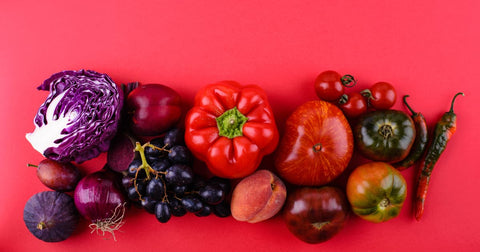Red vegetables aren't just visually appealing; they're packed with nutrients that contribute to a healthy and balanced diet. Their vibrant color often signifies a wealth of antioxidants and other beneficial compounds. Let's delve into the world of 8 common red vegetables and explore their unique benefits.

Benefits of Red Vegetables: A Nutritional Powerhouse
Benefits of red vegetables are numerous, thanks to their rich content of:
-
Lycopene: A powerful antioxidant associated with heart health and cancer prevention.
-
Anthocyanins: Antioxidants that contribute to cell protection and cognitive function.
-
Vitamin C: Supports immune function and collagen production.
-
Fiber: Promotes digestive health and regularity.
-
Vitamins and Minerals: Provides a wide range of essential nutrients.
1. Tomatoes: The Culinary Staple
Tomatoes are a versatile fruit, often used as a vegetable in culinary applications. They are rich in lycopene, vitamin C, and potassium. They are wonderful raw in salads, cooked in sauces, or roasted for a deeper flavor.
2. Radishes: The Peppery Bite

Radishes are known for their crisp texture and peppery flavor.
What Do Radishes Taste Like? A Zesty Kick
What do radishes taste like? They offer a refreshing, slightly spicy, and peppery taste, adding a zesty kick to salads and snacks.
Benefits of Radish: A Digestive Aid
Benefits of radish include:
-
High fiber content, aiding digestion.
-
Rich in vitamin C, supporting immune health.
-
Contains antioxidants that protect against cell damage.
3. Red Bell Peppers: The Sweet Crunch
Red bell peppers are sweeter than their green or yellow counterparts. They are a great source of vitamin C, vitamin A, and antioxidants. They are delicious raw, roasted, or stuffed.
4. Beets: The Earthy Sweetness
Beets are known for their earthy sweetness and vibrant color. They are rich in nitrates, which may improve blood flow and lower blood pressure. They can be roasted, pickled, or added to salads.
5. Red Onions: The Pungent Flavor
Red onions offer a milder pungency than yellow onions. They are rich in antioxidants and may have anti-inflammatory properties. They are great in salads, sandwiches, and salsas.
6. Red Cabbage: The Crunchy Delight

Red cabbage is a crunchy and colorful addition to salads and slaws. It is rich in vitamin C, vitamin K, and antioxidants. It can also be sautéed or pickled.
7. Rhubarb: The Tart Treat
Rhubarb, while botanically a vegetable, is often used in desserts. It has a tart flavor and is rich in fiber and antioxidants. It's commonly used in pies, jams, and compotes.
8. Red Potatoes: The Versatile Tuber
Red potatoes have thin skins and a waxy texture. They are a good source of potassium, vitamin C, and fiber. They are excellent boiled, roasted, or mashed.
Food Intolerance and Red Vegetables: Potential Sensitivities
While red vegetables are generally healthy, some individuals may experience digestive issues due to food intolerances or sensitivities.
Food Intolerance Test Kit: Identifying Triggers
If you suspect a food intolerance, a food intolerance test kit can help identify specific triggers. By eliminating or limiting these foods, you can improve your digestive health and overall well-being.
Key Takeaways:

-
Red vegetables are rich in antioxidants and essential nutrients.
-
They offer a variety of flavors and textures, making them versatile in culinary applications.
-
Understanding potential food intolerances is crucial for maintaining digestive health.
Remember, this article is intended for informational purposes only and should not be considered a substitute for professional medical advice. If you have any concerns about your health or dietary choices, consult a qualified healthcare professional.
Frequently Asked Questions:
1. Are all red vegetables high in lycopene?
While lycopene is a common antioxidant in red vegetables, not all of them are equally high in this compound. Tomatoes and watermelon are particularly rich in lycopene.
2. Can I eat radishes raw?
Yes, radishes are often enjoyed raw in salads or as a crunchy snack. You can also cook them, but their peppery flavor might become milder when cooked.
3. What are some ways to reduce the strong flavor of red onions?
Soaking sliced red onions in cold water for about 10 minutes can help mellow their pungency. You can also try pickling them or cooking them, which can reduce their sharpness.
4. Are there any red vegetables that are particularly good for gut health?
Red cabbage is a good source of prebiotics, which can help nourish beneficial gut bacteria and promote a healthy microbiome.
5. I'm experiencing digestive issues after eating red vegetables. Could it be a food intolerance?
Yes, it's possible to have a food intolerance or sensitivity to certain red vegetables, such as tomatoes or red peppers. Consider a food sensitivity test to identify potential triggers and manage your symptoms effectively.


.png?v=1737390083)
.png?v=1737187409)


